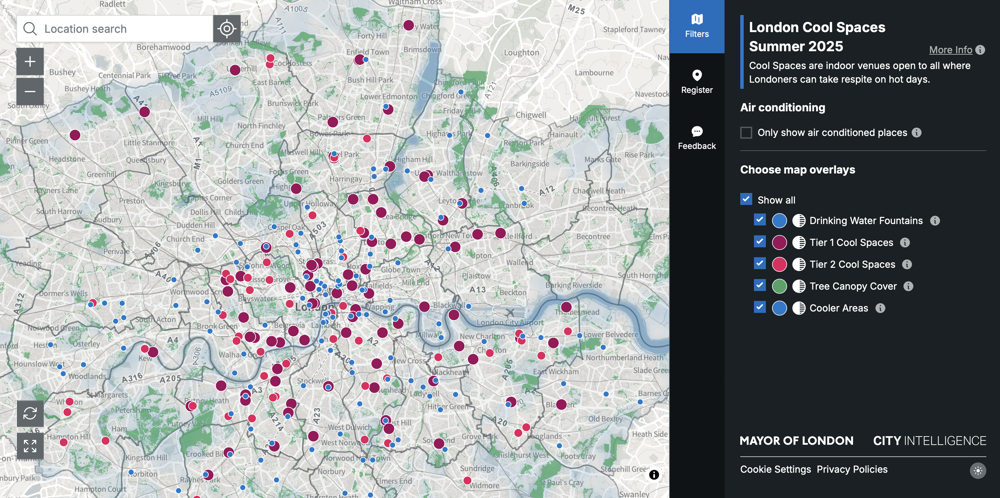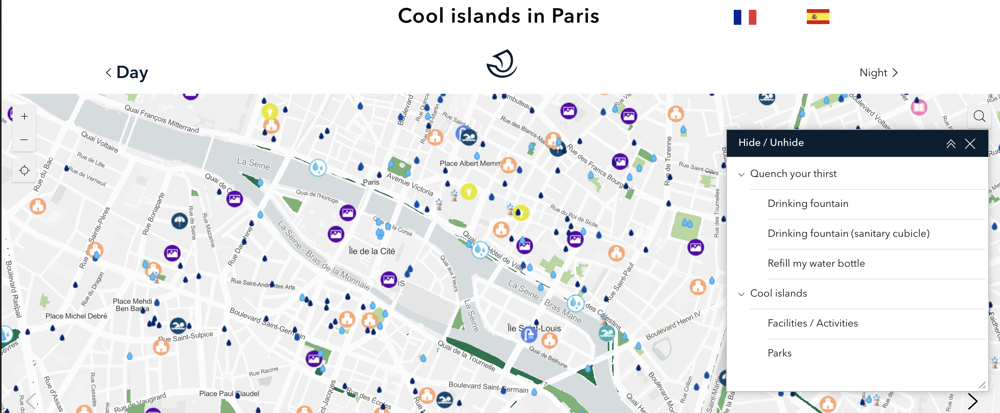Cooling centres, cool spaces and cool islands
Cooling centres also known as cool spaces are locations across a city or region that are highlighted as places for members of the public to seek relief from the sun during a heat wave or extreme heat weather event.
Common in communities that suffer from extreme heat and extreme weather warnings, these centres may offer air conditioning and other resources such as water and food, acting as a refuge for those experiencing heat stress. These centres may offer a lifeline to vulnerable persons or groups who maybe worst impacted by heat, such as the elderly, infants and young children, people with chronic health conditions, pregnant women, and people with disabilities.
In London the Cool Spaces app programme highlights indoor venues and outdoor spaces open to all members of the public where Londoners can take respite on hot days. Indoor Cool Spaces were put forward by boroughs, community groups, faith-based and other organisations following an invitation to register by the Greater London Authority (GLA). These indoor Cool Spaces are then classified according to two tiers:
- Tier 1 Cool Spaces have all the key amenities to cope in hot weather: lower temperatures than outdoors, free seating space for rest and recovery, free drinking water and toilets. They are accessible to disabled people, open at least five days a week and at least from 10am to 5pm.
- Tier 2 Cool Spaces may not be accessible to disabled people, may not have toilets and be open less frequently, but at least two days a week.
The tiered approach to classifying Cool Spaces is meant to provide Londoners with an understanding of what they can expect from venues and how some Cool Spaces can better suit their needs. The full criteria for the different tiers can be found here.
Parks and outdoor spaces that provide shade, shaded seating, drinking water and toilets are also signposted but may still be very hot during hot weather. The tree canopy layer intends to provide indicative complementary information on potential shade in public open areas across London.
The cool spaces map uses data from the following sources:
- Tree canopy cover: Data from London Tree Canopy Cover.
- Water fountains: Data from GLA Drinking Fountains Map.
- Basemap: Contains OS data © Crown copyright and database rights 2024.
For advice on staying safe in hot weather, read the Mayor’s guidance on keeping cool on hot days.
In Paris a similar approach referred to as Cool islands in Paris listing areas with water spray, permanent and temporary shading, public showers, swimming pools, air-conditionned library. oasis school yards, museum, places of worship and borough halls. It also indicated areeas where vegitation over 8metres covers up to 25%, 25-50% or over 50% of the ground area and areas where drinking facilities are available.
These mappiing solutions have been dveleoped hand-in hand with urban planning across the city with an increase in the use of Blue Green Infrastructure to help mitigate extreeme weather patterns, with plans to plant 170,000 trees across the city by 2026. Other cities also plan extensive tree planting programmes to help tackle extreeme weather and other benefits such as Central Sydney in Australia, with extensive tree planting and Seville, Spain, along with increased awnings and what it calls it s“policy of shade". Other models such as the green corridors which are shady routes through the city of Medellin in Colombia, or the Rotterdam Rooftop Walk initiative.which aims to add vegetatin and greenery to some 900,000 square metres of rooftops across the city. All these initiatves can help create pockets in a city where extreeme heat events can have a reduced impact on citzens and can be a lifeline for vulnerable people.
[edit] Related articles on Designing Buildings
Featured articles and news
The UK's Modern Industrial Strategy: A 10 year plan
Previous consultation criticism, current key elements and general support with some persisting reservations.
Building Safety Regulator reforms
New roles, new staff and a new fast track service pave the way for a single construction regulator.
Architectural Technologist CPDs and Communications
CIAT CPD… and how you can do it!
Cooling centres and cool spaces
Managing extreme heat in cities by directing the public to places for heat stress relief and water sources.
Winter gardens: A brief history and warm variations
Extending the season with glass in different forms and terms.
Restoring Great Yarmouth's Winter Gardens
Transforming one of the least sustainable constructions imaginable.
Construction Skills Mission Board launch sector drive
Newly formed government and industry collaboration set strategy for recruiting an additional 100,000 construction workers a year.
New Architects Code comes into effect in September 2025
ARB Architects Code of Conduct and Practice available with ongoing consultation regarding guidance.
Welsh Skills Body (Medr) launches ambitious plan
The new skills body brings together funding and regulation of tertiary education and research for the devolved nation.
Paul Gandy FCIOB announced as next CIOB President
Former Tilbury Douglas CEO takes helm.
UK Infrastructure: A 10 Year Strategy. In brief with reactions
With the National Infrastructure and Service Transformation Authority (NISTA).
Ebenezer Howard: inventor of the garden city. Book review.
The Grenfell Tower fire, eight years on
A time to pause and reflect as Dubai tower block fire reported just before anniversary.
Airtightness Topic Guide BSRIA TG 27/2025
Explaining the basics of airtightness, what it is, why it's important, when it's required and how it's carried out.
Construction contract awards hit lowest point of 2025
Plummeting for second consecutive month, intensifying concerns for housing and infrastructure goals.
Understanding Mental Health in the Built Environment 2025
Examining the state of mental health in construction, shedding light on levels of stress, anxiety and depression.























